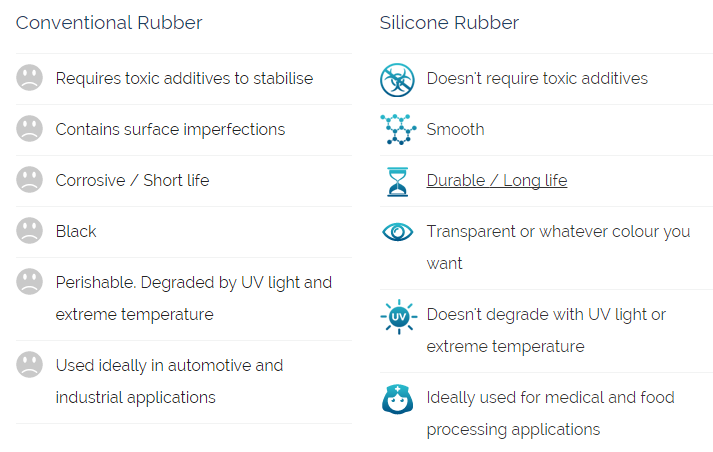Both rubber and silicone are elastomers. They are polymeric materials that exhibit the viscoelastic behavior, which is generally called elasticity. Silicone can be distinguished from rubbers by the atomic structure. In addition, silicones have more special properties than normal rubbers. Rubbers are naturally occurring, or they can be synthesized. Based on this, silicone can be differentiated from rubber.
Rubber
Generally, all the elastomers are considered as rubbers in which dimensions can be changed largely by stressing, and can be returned to the original dimensions after removing the stress. These materials show a glass transition temperature due to their amorphous structure. There are many types of rubbers or elastomers like natural rubber, synthetic poly isoprene, styrene butadiene rubber, nitrile rubber, polychloprene, and silicone. But natural rubber is the rubber which comes to our mind when considering rubbers. Natural rubber is obtained from the latex of Heveabrasiliensis. Cis-1, 4-polyisoprene is the structure of natural rubber. Most of the rubbers contain polymer chains of carbon. However, silicone rubbers contain silicon in polymer chains instead of carbon.
Silicone
Silicone is a synthetic rubber. It is synthesized by modifying silicon. Silicone consists of a backbone of silicon atoms with alternating oxygen atoms. As silicone has high energy silicon-oxygen bonds, it is more resistant to heat than other rubbers or elastomers. Unlike in other elastomers, the inorganic backbone of silicone makes its resistance to fungus and chemicals higher. In addition, silicone rubber is resistant to ozone and UV attacks because the silicon oxygen bond is less susceptible to these attacks than the carbon- carbon bond of the backbone in other elastomers. Silicone has a lower tensile strength and lower tear strength than the organic rubbers. However at high temperatures, it shows excellent tensile and tear properties. This is because the variation of properties in silicone is less at high temperatures. Silicone is more durable than other elastomers. These are few of the beneficial properties of silicone. Regardless, the fatigue life of silicone rubbers is shorter than the organic rubbers. It is one of the disadvantages of silicone rubber. In addition, its viscosity is high; therefore, it causes manufacturing problems due to poor flow properties.
Rubber is used for many applications like cookware, electronics, automotive applications etc, because of their elastic behavior. As they are waterproof materials, they are used as sealants, gloves etc. Rubbers or elastomers are excellent materials for insulating purposes.
From all the rubbers, silicone is much better for thermal insulation due to its heat resistance. Silicone rubber offers special properties, which organic rubbers do not posses.
Silicone vs rubber
Conventional Rubber
Requires toxic additives to stabilise
Contains surface imperfections
Corrosive / Short life
Black
Perishable. Degraded by UV light and extreme temperature
Used ideally in automotive and industrial applications
Silicone Rubber
Doesn't require toxic additives
Smooth
Durable / Long life
Transparent or whatever colour you want
Doesn't degrade with UV light or extreme temperature
Ideally used for medical and food processing applications

Doesn't require toxic additives
As opposed to rubber, the production process to create quality silicone does not require the addition of questionable stabilising agents. Although rubber production processes are being continually adapted in attempts reduce the use of arguable carcinogens, this inevitably reflects on the stability of the rubber. Whereas with silicone, the production process is such, that the resulting material is completely stable without the need for toxic additives.

Smooth
Basic science tells us that under a microscope a smooth surface is more hygienic than a rough/cracked surface. The uneven surface of rubber allows for microscopic germs and bacteria to reside inside. This is a problem that only gets worse with time as the rubber begins to deteriorate, allowing it to harbour more and more bacteria. Silicone is completely smooth on a microscopic level and remains so throughout its life, making it unquestionably more hygienic than rubber alternatives.

Durable / Long life
The life of any product should always be seen in relation to its cost. Something is not necessary cheap if it continually needs replacing. Durability in commercial materials such as rubber and silicone is a financial concern as well as a hygienic issue. On average silicone lasts four times longer than rubber. At just twice the price of rubber, this clearly delivers sizeable financial savings long-term, as well as cutting down on the hassle and manpower to replace items.

Transparent or whatever colour you want
There's a lot to be said for transparency. If a problem can be seen, it can be fixed. If a length of black rubber tubing becomes blocked, there is no way of telling exactly where that blockage is. If the blockage is complete, then the tubing is redundant. However, maybe worse would be a partial blockage, restricting flow, slowing productivity and negatively effecting hygiene. Silicone is clear. Blockages and problems can be spotted easily and fixed straight away, without any detriment to quality. Alternatively, you can add dyes to the silicone mix in the manufacturing process to create whatever colour you want.

Doesn't degrade with UV light or extreme temperature
As soon as anything starts to degrade, it starts to become unstable and cause pollutants. Rubber is a "dying" material; continually changing, it is degrading from the moment it is produced and this process is considerably speeded up by stress, pressure, changes in temperature and by exposure to UV light. Silicone doesn't. It's is not effected by UV light or extremes in temperature. Eventual fails will result in simple tears, providing a clear indication that it needs replacing, without causing any long term contamination.

Ideally used for medical and food processing applications
Looking at the unique properties of silicone compared to rubber, it is easy to see why silicone is the material of choice for medical applications and for use within the food processing industry. Where repetitive action is required, the flexible nature of silicone can withstand continuous stresses and pressures for a far longer period than rubber and without corroding or cracking in the process. This leads to less contamination, financial savings and an all round more hygienic environment.
Post time: Nov-05-2019

